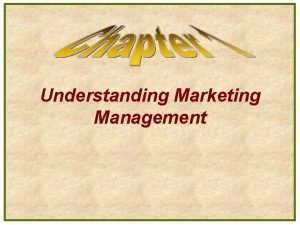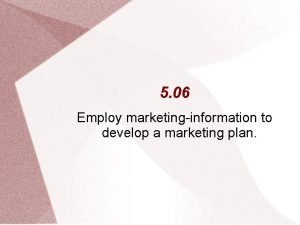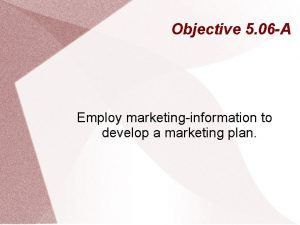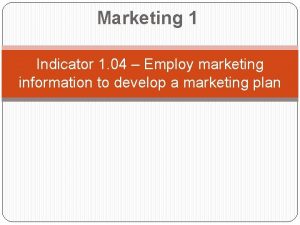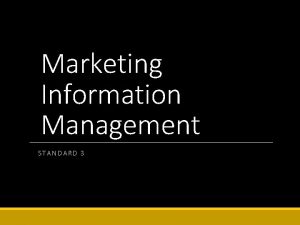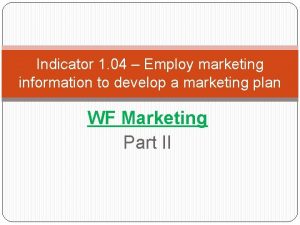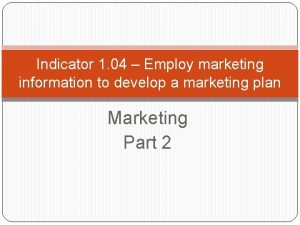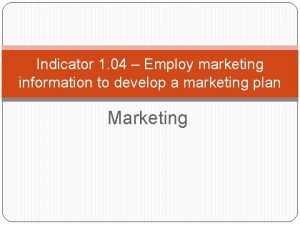Marketing Management Indicator 1 03 Employ marketinginformation to












- Slides: 12

Marketing Management Indicator 1. 03 Employ marketing-information to develop a marketing plan

Benefits associated with having a marketing plan • Understand past marketing decisions and outcomes better • Allows the opportunity to look back and see what strategies worked well— and didn’t • Understand target market(s) better • No success unless the customers’ needs and wants are met. • Setting goals • Set goals are easier to remember, stick to, measure, and achieve. • Planning marketing strategies with more precision • Provides clear guidance on what strategies will be used and when. • Obtain funding • Potential investors will want to see a plan before putting money into a business. • Provide direction in organization • Clear direction is provided for everyone • Tracking progress more effectively • Can track progress in a measurable way

Components of a marketing plan • • Executive summary Situation/SWOT analysis Desired target market Marketing objectives Marketing strategies and programs Financial plans Performance and implementation Appendix

Purpose of marketing plan components • Executive summary • Serves as an introduction to the marketing plan • Allows the reader to understand the purpose of the marketing plan • Situation/SWOT analysis • Determines firm’s current marketing situation • Answers the basic question of “How are things now? ” • Serves as a snapshot of the business’s current state of affairs as related to marketing • Desired target market • Information on the target market the company desired to reach • If NOT for a new target market/product, may be skipped • Marketing objectives • Outlines the specific marketing objectives that the company wants to achieve • Serve as a foundation for achieving sales and overall financial objectives

Purpose of marketing plan components • Marketing strategies and programs • Heart of the marketing plan • Identifies the general marketing strategy (growth, stability, market exit) • Financial plans • Provides details on the expected expenses and profits of a plan’s program • Performance and implementation • Give expected results and indicates how the plans’ progress will be measured • Appendix • Holds charts, graphs, or miscellaneous materials related to the plan

Items/Factors that use Sales Forecasts • New product decisions • Product scheduling • Financial planning • Inventory planning and procurement • Distribution • Human resource planning

The Time Frame of Sales Forecasts • Short-range forecasts • Last fewer than three months • Intermediate forecasts • Last three months to two years • Long-range forecasts • Last more than two years

Factors which affect how far ahead a business should predict sales • Continual decisions in planning, scheduling, inventory and staffing in production, procurement and logistics activities are short range • Budgetary planning, cost control, marketing new products, sales force compensation plans, facility planning, capacity planning and process selection and distribution planning are intermediate • Whether to enter new markets, develop new products or services, expand or create new facilities, or arrange long-term procurement contracts are long-range

Qualitative vs. Quantitative Forecasting Methods Qualitative • Relies on subjective data that reports opinions rather than historical data Quantitative • Uses statistical computations such as trend extensions based on past data, computer simulations, and economic models.

Factors affecting Sales Forecasts • Sales Fluctuations • Who are customers? • Number of customers? • Diversity of customers? • New Products • Very new? • Not similar to other items or services? • Market Conditions • Change for NUMEROUS reasons • Ex: Quick jump in fuel prices • People stop driving unnecessarily • People buy less gas • Ex: Release of new technology • Makes previous technology obsolete (Smart Phones replaced Palm Pilots and cell phones)

Business Activities which use Sales Forecast Information as a Planning Tool • • • • • Volume of attainable sales Material costs Labor costs Equipment costs Markets for products Plans corporate strategy Develops sales quotas Determines the number and allocation of salespeople Decide distribution channels Prices products or services Analyzes products and product potential in different markets Decides on product features Determines profit and sales potential for different products Constructs advertising budgets Determines the potential benefits of sales promotion programs Decides on the use of various elements of the marketing mix Sets production volume and standards Chooses suppliers Defines financing needs Determines inventory standards

Why not all businesses use sales forecasts • Forces decisions to be based on facts rather than hunches. • Don’t want to look for historical information (there are no past sales) • It is a difficult and hard process • Some do not want to put forth the effort and energy • Doing it correctly is the key to understanding your business’s future.
 Employment florida marketplace
Employment florida marketplace Employ florida background wizard
Employ florida background wizard How many reaping entries will katniss have in her 16th year
How many reaping entries will katniss have in her 16th year What does artemidorus plan to do
What does artemidorus plan to do Employflorida
Employflorida Employ florida marketplace
Employ florida marketplace Placators
Placators Employ florida marketplace
Employ florida marketplace Employ
Employ 071-com-4407
071-com-4407 With stars
With stars Swin employ
Swin employ Understanding marketing management
Understanding marketing management












